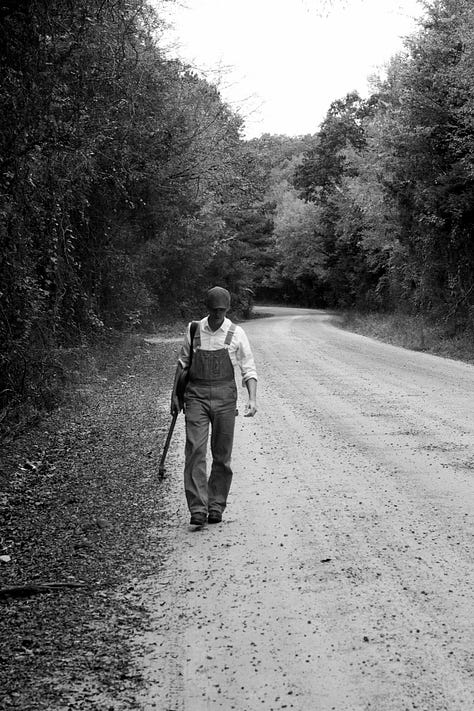
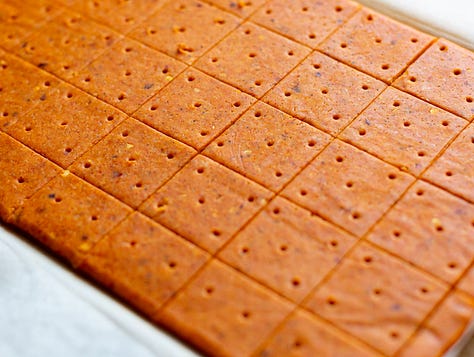
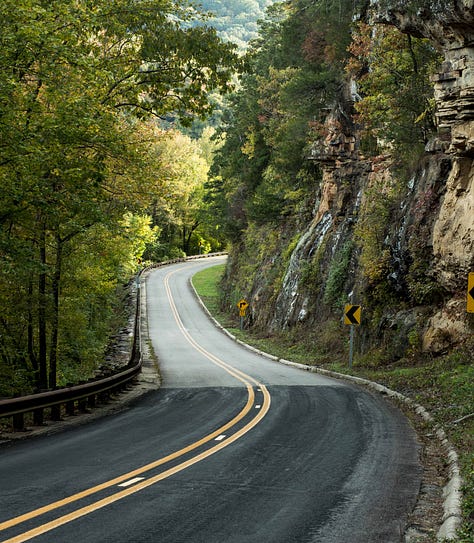
This is an essay from a project in 2018 I called The Baker Maker Roadshow. On a vintage bicycle with a banjo and ingredients for biscuits, I rode rural roads in my native state of Arkansas. My hope was to cold-call homes, meet people, bake for them, and connect my present-day Vermont life to my roots through shared food. (There’s another essay from this project in the Curio, “Afternoon in Jethro,” which appeared here in January. More backstory and context is included with that piece.) This is the story of an evening I spent near the town of Red Star, Arkansas.
And yes, there is a companion recipe, too. As I packed up my things and readied to leave that evening in Red Star, I was given a parting gift of some homegrown, smoked, and dried chipotle powder. Inspired by the qualities of the chipotle, I wrote a crispy, spicy, cheesy, heat-kissed version of a Cheez-it. Behold: the Firecracker. Thanks for reading, y’all.
Evening in Red Star
Driving east on Highway 16 to the drop-off point, I press my face to the window of my dad’s truck. Landmarks blur past. Greasy Creek, Panther Creek, Lick Branch. Rocky Hollow, Skinner Hollow, Dog Branch. The White River snakes its sandy bottom through hairpin curves under the eyes of limestone bluffs and trash-piled yards. Things here move but never seem to change.
“Welcome home,” it seems to say. It’s been a while and I don’t feel like talking. Mouth closed, I won’t kiss this place.
Dad pulls the truck over, stopping in a billow of dust between Boston and Red Star. The towns were here long before now. These days, little remains beyond a spit of red dirt. An abandoned house sits with leaning outbuildings, a stone well, and exposed knob-and-tube. A young oak props up the porch posts. Nature lends a hand.
I climb out with no hustle, unload the bike, and strap on my basket with ingredients, pots, pans, and measuring spoons borrowed from my parent’s kitchen. Each one has its own history, pinned there by my mama. “That was a wedding gift,” and “you rode in that basket when we moved from Kentucky.” “This was Oma’s.” I loop my arms into the straps of the banjo bag she made and kick myself downhill.
“Good luck,” says my dad as his face disappears over my shoulder. I search for something to acknowledge the moment. I need courage — a bit of a belief I can hold in my pocket or suck like a lozenge. Nothing comes to me until gravity pulls the bike downhill. “I have faith in face-to-face.” That’s what I tell myself.
My tires hum as I gather speed. I wonder if the 1932 Elgin can handle it and then, just as it gets dangerous, I stomp the pedal brake and careen onto the rutted, steep lane that leads — somewhere unseen ahead — to the home of Viiram and Donna McKenney. The hill is like a wall. I stand and push my boots into the cranks to hold momentum. The bike lurches side to side with my effort. Progress slows. “Do NOT walk the bike!” Not here, not on the very first hill of the very first day on this trip that I might like to quit before beginning. But, as if timed or designed, the incline flattens just as the mountain was set to push me over. And I continue.
A bend straightens and the road leads my handlebars into the late afternoon. Black oaks break fall sun into star-shaped shadows; I avoid a pile of bear shit. The pedaling eases, my bike creaks and squeaks; I can handle this. I can pedal country lanes and I can breathe. I can spin circles with my feet, ending to begin, again; this, I can do, if nothing more.
Cut like a vacant lot and butted with tree walls, a vegetable patch appears — I must be close. Harlequined peppers, blazing amaranth, okra spears, and Thai basil hang frost-burned next to rows that have been prepared for planting. A woman bends, tool in hand, harvesting onions. I roll past quietly, afraid of startling her. Giant shapes rouse quickly — one more wolf than dog — and erupt as I approach. Ozark doorbells have fur.
Viiram steps out. A 60-something land surveyor, organic farmer, and singer-songwriter with flowing hair who self-describes as “weed positive,” Viiram McKenney has lived in the Ozarks for more than 40 years. He greets me warmly as I lean my bike against a flatbed trailer. The dogs calm down some and sniff my hand without eating it. We move into the gated garden.
I meet Donna, smiling and gentle. I feel peace when I’m near her. It seems like she might kneel so that all the creatures of the forest can bring offerings while songbirds braid her hair. She saves that trick for another visit.
I’m beginning my week of talking, bike riding, baking, and banjo-playing with Viiram and Donna after they responded to an ad I placed in the local paper. Thinking I’d want some places to stop and not sure if the door-knock roulette would work, I had taken out an ad before embarking, looking for people that might let me in the door. Viiram responded and we scheduled my visit.
I thought they might feel like home turf. My parents had their own trial period as Arkansas hippies. The back-to-land movement made its way to our house with home births, midwifery, placenta soup, and garlic remedies. I understand this culture better than box churches, Confederate flags, meth, and the other stereotypes that hang around like hickory smoke and no-seeums. The McKenneys are my people.
Standing at 2,200 feet, their house — with its octagonal outbuildings, and magic yellow school bus parked out front — are at the height of the land. A cup of water poured from the front door will reach the Mulberry River; poured from the side door will hit the Little Mulberry; and, from the back door, will trickle into the headwaters of War Eagle Creek. Here, we are at the source, the center of a circle from which things flow. Viiram describes this further as we walk the property.
He tells the story of the year that he took a hoe and baling wire and went into his field. With the hoe stuck in the ground and wire held taut, he etched 12 perfect concentric rings in the dirt. Then he returned to the center and built a dirt pyramid, aligning its points with the points of a compass. He planted oregano in the center and jalapeño peppers at the four compass points. The circle was 60 feet in diameter and, once filled, contained 900 broccoli plants interspersed with onions. The harvest was epic, biblical even. He loaded the broccoli into an empty refrigerator on the back of his truck and plugged it in overnight before going to market. So goes the parable of the biodynamic broccoli fortune.
As daylight wanes we step into their kitchen: a space the color of turmeric and oranges. Handmade maple cupboards and shelves are lined with an apothecary’s array of gallon glass jars holding home-dried herbs, pickled things, and bulk ingredients. A large copper Chambers oven from the 1940s glows with the patina of countless meals.
When I imagined this trip I thought that the kitchen might be a good place to begin. Some lives are defined by the garage, playroom, or backyard — but for me, it’s the true living room. It’s the source of more than sustenance. We’ve gathered around fire, forging bonds, for longer than we can record. ”I’m gonna to make myself at home, if that’s ok?” I say, and set to work making biscuits.
I mix whole wheat flour with all-purpose and add salt, baking powder, and cold butter. I work the butter into the flour with my fingers then add milk. I stir briefly to combine, then dump the dough onto the counter. I roll it with my grandmother’s dowel rolling pin, then fold, roll again, and cut circles and place on a baking tray.
We sit at the table while the biscuits bake. I dig a piece of home-cured meat out of my basket and Viiram brings good cheese, beer, and wine. Donna offers her pickled cucumbers and radishes and sets out local honey and butter. Viiram says, “She’s the pickle queen, I taught her and she surpassed me.” She beams.
Donna speaks of her childhood on the Mississippi River as the daughter of a commercial fisherman: fried catfish, canned vegetables, daily trips to the bakery for fresh bread, and homemade meringue pie made with leftover citrus from the 7-Up plant. Viiram recounts his path to rural Arkansas and his long relationship with baking breads and cinnamon rolls.
Talk of food leads us upstream — back to home, and family. “The older my parents got, the more conservative they became,” offers Donna.
I lean in. “How did you deal with that?”
“Oh, you know, I kind of didn't. I mean, I'm me, and they know how I feel about things. My sister and I met two days after the 2016 election. We didn’t vote for the same person. We hugged — I love her — but we just don't go there anymore."
A buttery wave of toasty biscuit aromatherapy takes over the kitchen. At 20 minutes they are ready — golden, oven-kissed, flaky, and steaming when split. I set the whole scorching tray on the table and we make our way through the batch; some plain, some with butter, some with cheese, and many with honey, shoveled between sips of beer and bites of the spicy pickles.
I ask, “How do we find empathy when we don’t agree?”
“That’s a hard one for me,” Donna says, “to not judge people. I mean, I have my lifestyle, my beliefs and there are lots of people that don’t have the same beliefs. And it’s hard to not judge.”
There must be common ground. “What do you think connects us that’s deeper than politics or red or blue states?” I ask. Donna answers, “Well, I think food, the gardens — I’ve found a lot of common ground working at the [farmer’s] market. I know we don’t agree on things — but we can talk about the garden. We can talk about what we do with the food we pick from our gardens — we can talk about the bugs that eat our food.” She laughs. “I find common ground there.”
But, “one of the problems is that we see us and them…” she notes.
“It’s us, we’re all the same — we’re all us,” says Viiram. “There is no them.” And Donna piles on, “It’s fabricated — we need to stop being divided. We are allowing ourselves to be divided, and that’s the problem.”
Darkness falls and Donna realizes that she forgot to put up the chickens. Between the constant threat of black snakes and whatever else is hiding in the woods, it’s best if they are tucked in, coop closed, for the night. Headlamps on and wolf pack in tow, we shut the door. “Goodnight ladies.”
Walking back to the house it’s so dark I can’t see my feet. I’m floating. I feel a closeness that’s unexpected — I may have survived my first visit. With Donna’s encouragement (and a jar of their homegrown smoked chipotle powder) I think of the walls I’ve been holding up against the world, against people I don’t know or understand. Are they falling down? No, but I’m looking at them.
A couple quick notes about these crackers. The level of heat can be dialed to your preference. For no heat, use only paprika. If you do want the heat, chipotle powder, chili flakes, cayenne, or any hot dried chili powder or pepper will work. I’ve chosen chipotle in a nod to the McKenneys — the smoked chipotle powder is the best I’ve ever had.
For the ratios used in this recipe my starting point was a Chef John recipe (which he credits to Joy the Baker who, in turn, credits Ready Made magazine).
Firecrackers
Cheddar cheese, sharp, 84g
Parmesan, (or Pecorino Romano, Asiago, or any flavorful hard cheese), 28g
All-purpose flour, 60g (½ cup)
Paprika (smoked, sweet, or Spanish), 5g (2 t)
Chipotle pepper* (chili flakes, or cayenne), dry, ground, 2.5g (1 t)
Salt, 3g (½ t)
Black pepper, 1g (½ t)

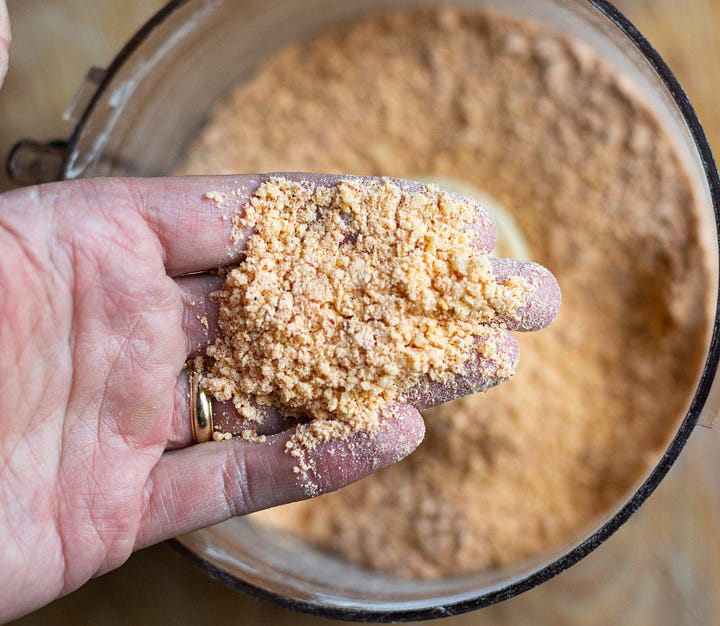
Cube or roughly cut up the cheese then add everything to a food processor fitted with a cutting blade. Pulse and chop until the mixture is fine-textured with a grain similar to something like breadcrumbs.
*For spiciness, this amount feels warm to me but not intense. Feel free to adjust the level to your preference.
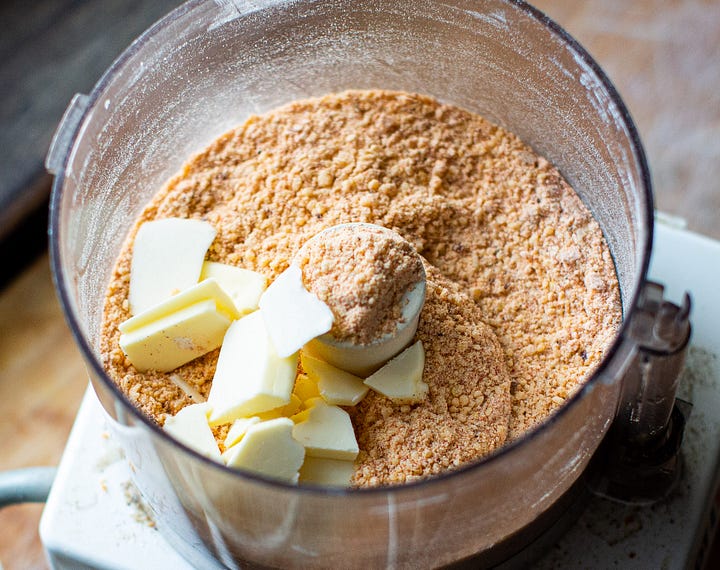

Butter, unsalted, cold, 28g (2 T)
Cube or slice the cold butter into pieces and add to the mixture. Run the processor until the mixture is homogenous and, as before, resembles bread crumbs.
Water, ice, 15g (1 T)
Add the ice water to the mixture and pulse or run briefly until a ball forms. If the mixture remains crumbly and doesn’t form a ball after 10 seconds or so, add additional ice water, 1 t (5g) at a time until a ball forms. (The upper limit on additional water is about 1 T (15g)). If it still doesn’t fully clump in the processor, remove the dough, knead briefly, and proceed. It will be fine unless something has been measured incorrectly.
Before shaping the cracker dough, preheat the oven to 400˚F with a rack in the lower portion (gas oven) or middle (electric).

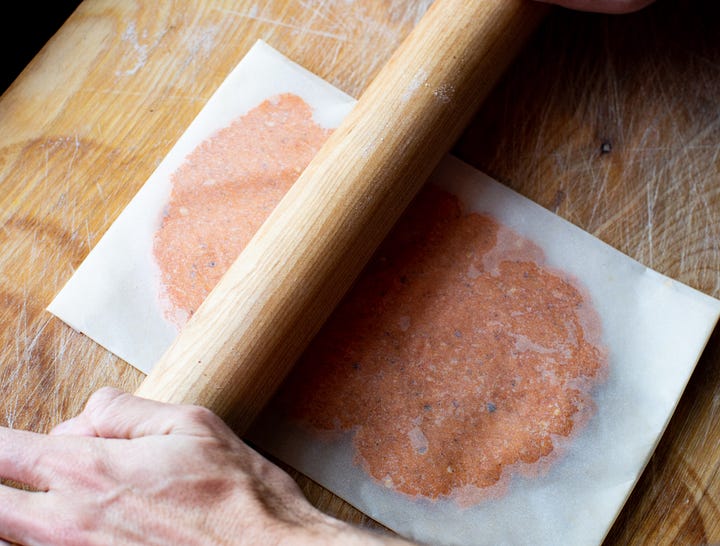
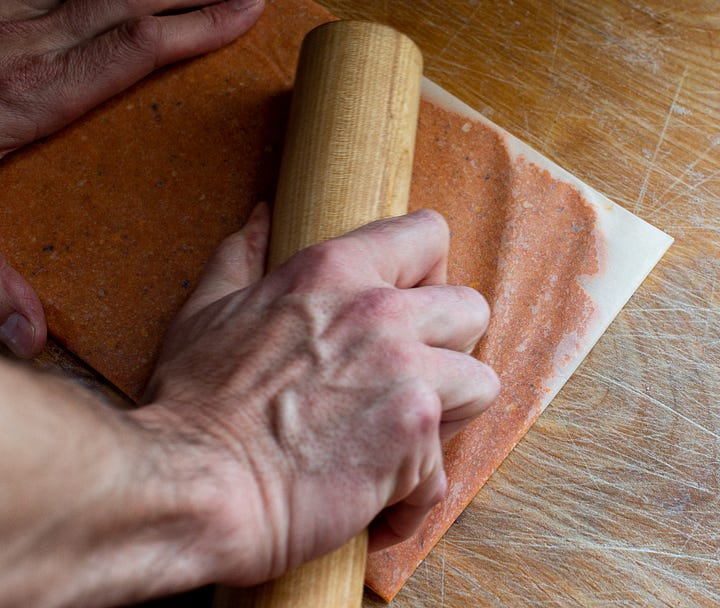

Shape the crackers. Using a half sheet of parchment paper (or a piece of rolled parchment, cut to 16” by 12”), fold into an envelope measuring 7” by 11”. (The idea here is that you make a little parchment package that will receive the dough and close on all sides.) Add the dough and smear, flattening slightly. Fold and close the paper over the dough then turn the package over so that the seams are facing down. Then, using a rolling pin, press, roll, or smooth the dough, pushing it into the corners, distributing it evenly. I like to run the rolling pin back and forth like a grader, checking to ensure that the thickness is as even and smooth as possible.
Chill in the freezer for 5 to 10 minutes.

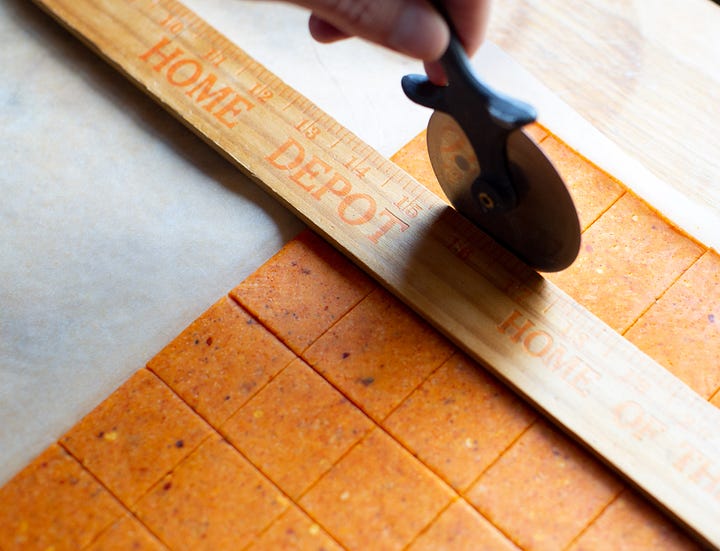
Remove the dough from the freezer and open the package. If the dough feels brittle, allow it to soften briefly — 1 to 2 minutes, depending on ambient temperatures — then cut into even squares, using a straight edge as a guide (a ruler works well). I mostly cut 1 ½” squares during testing but recently switched to 1” squares and that’s become my preference — the smaller pieces bake in less time with a crisper consistency.
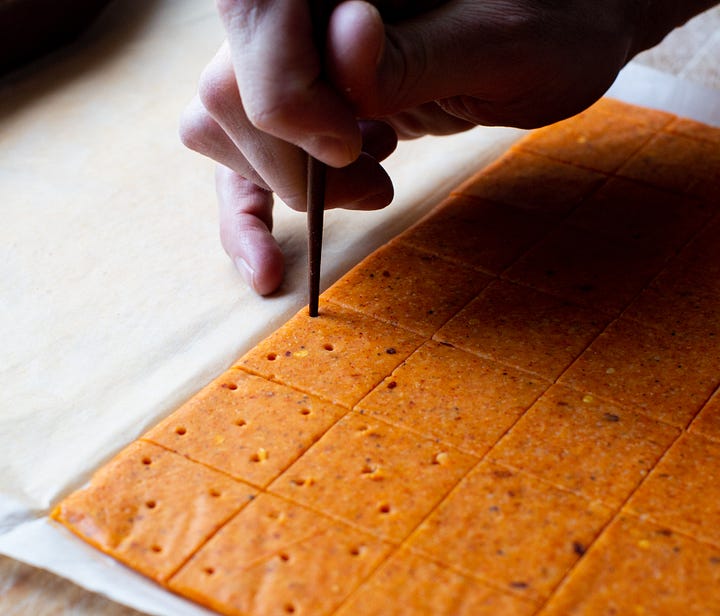
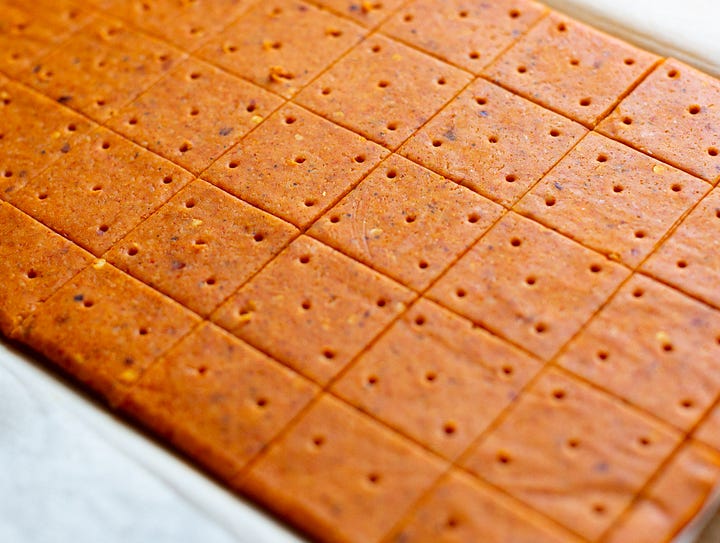
Pierce each cut cracker with a chopstick, making 1 to 5 holes in each.
If, after cutting and piercing, they feel tacky, return the crackers to the freezer briefly (leave them on the parchment). After they firm up they will be easier to move to a parchment-lined sheet tray before baking. (In cooler weather I’m able to avoid this — we’ll see what happens this summer. Also, I reserve the parchment that I use to shape the crackers, keeping it for subsequent batches. Fold it up and store on the freezer door.)
To transfer the crackers, use a flat metal spatula or similar and place them on the parchment-lined tray, distributing evenly.
Spritz (or brush gently) with a fine mist of water for a shiny exterior, then garnish with coarse salt to taste.
Bake at 400˚F for 5 minutes then reduce the heat to 350˚F for 8 to 12 minutes, depending on size and your oven. The crackers are done when the bottoms are golden and the whole house smells like toasting cheese. For maximum crispness, place the crackers on a cooling rack after baking and return to the off oven, allowing them to maximally dehydrate as they cool.
Note that the crackers will not be crisp until almost fully cooled. It’s hard to be patient but give it your best shot. If, after cooling they aren’t as crisp as you’d hoped, return them to a low oven (200˚F) for an additional 15 to 20 minutes, checking to ensure they don’t take too much color.
And friends, I have to give a special shout to the many people around me that make all of this possible. My family, who all have stepped in to shoot an image when my hands are full, to read early versions of each newsletter, or simply help dispatch the mountain of baked goods that accumulate during testing. Thank you. And, to Posie Brien who has read, re-read, corrected, and patiently helped me to bring clarity, beauty, comprehension, and correct grammar (and spelling) to the mess of thoughts that land here. Deep gratitude to all. None of this happens without you.

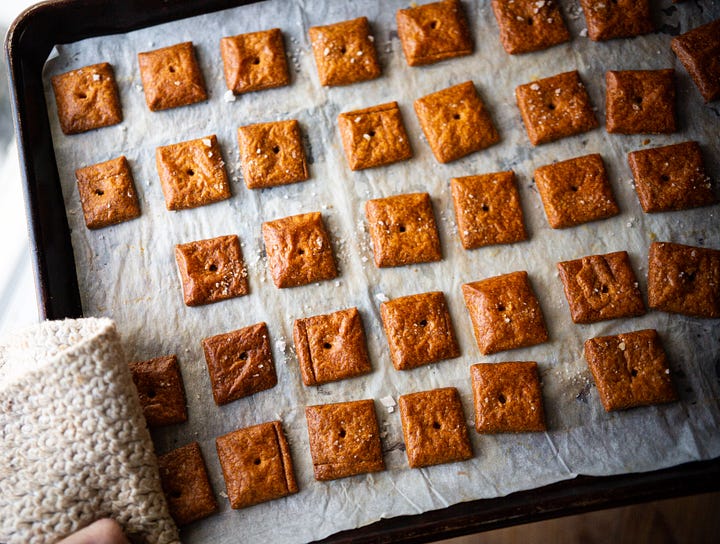




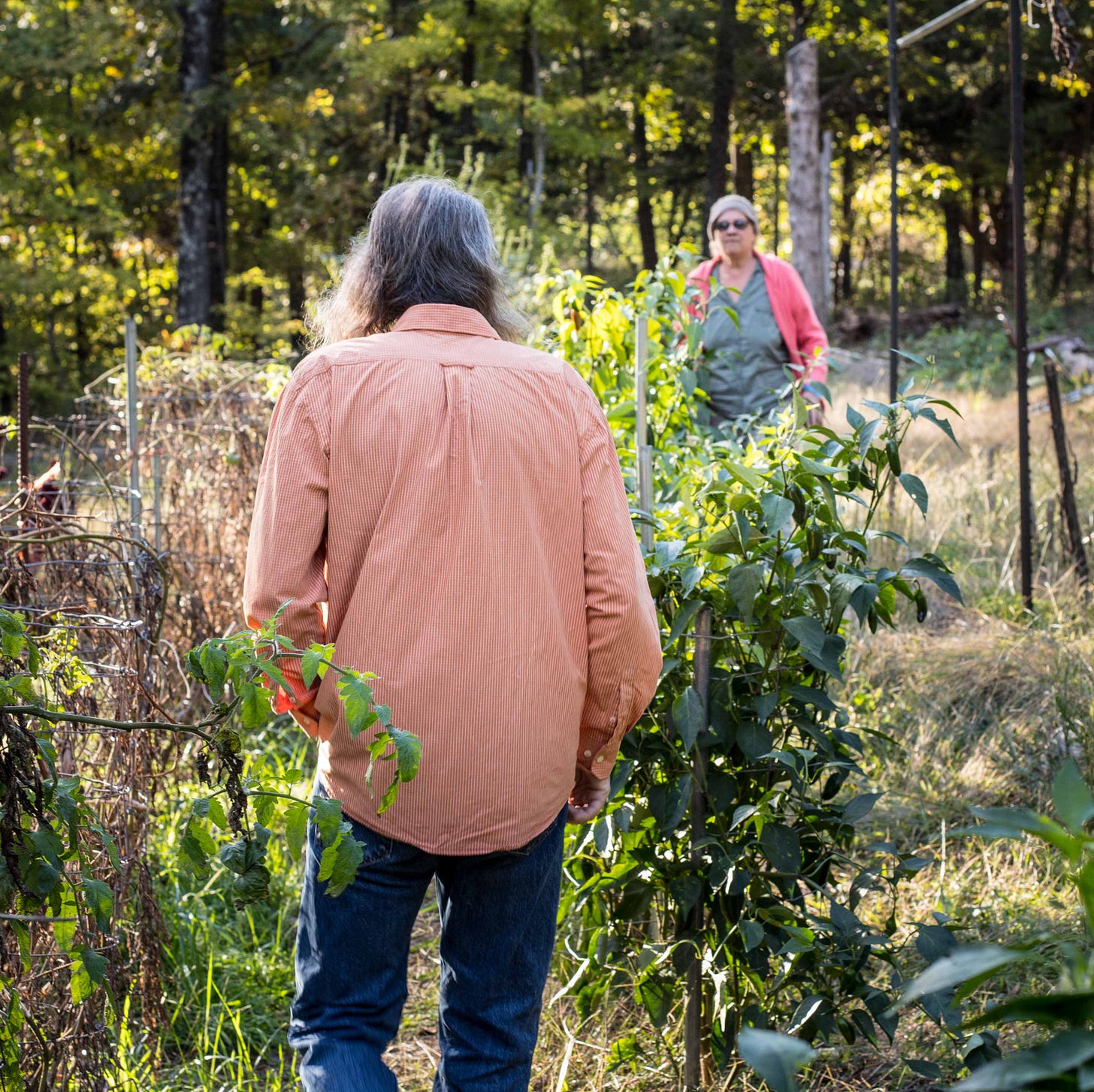

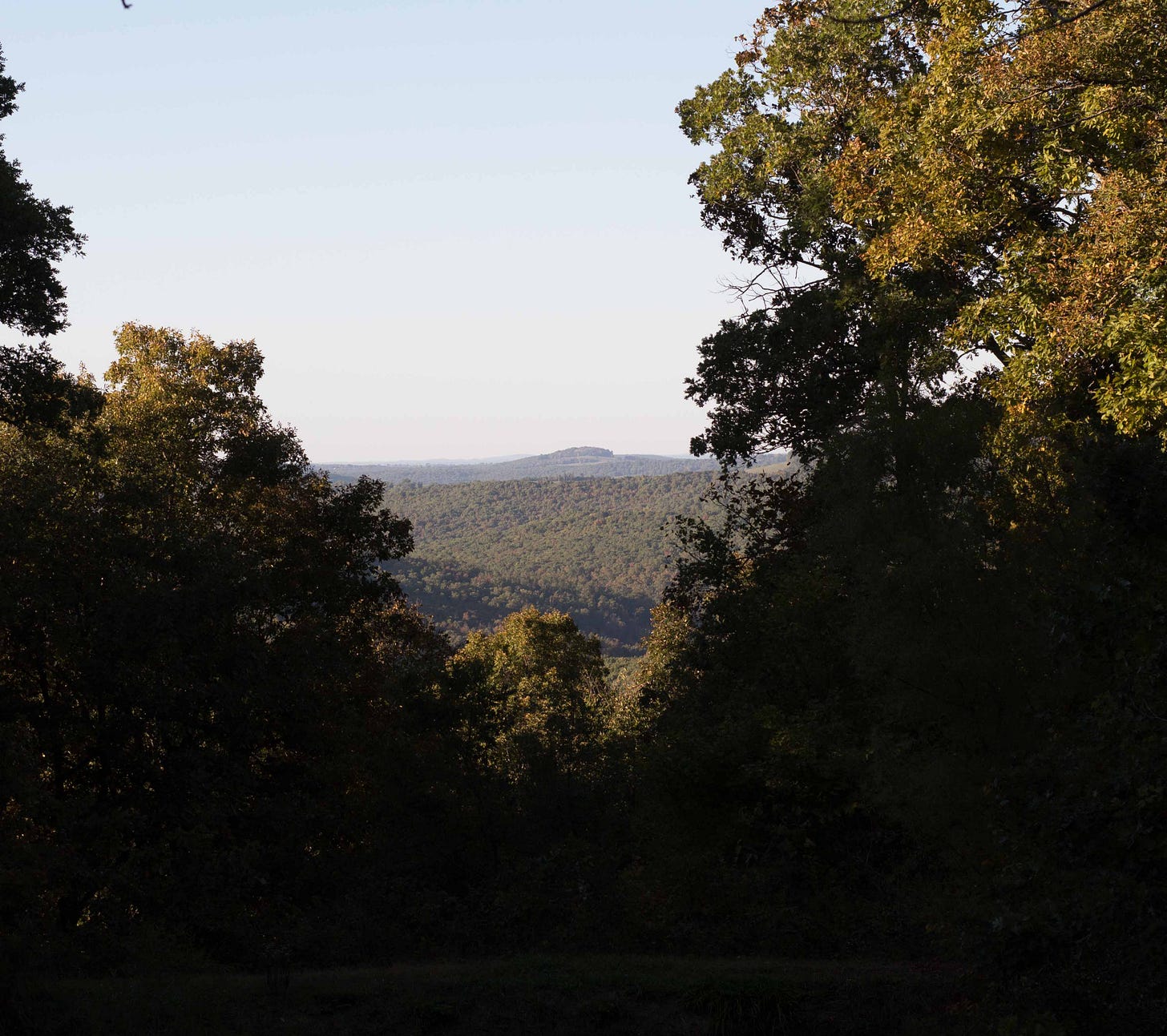
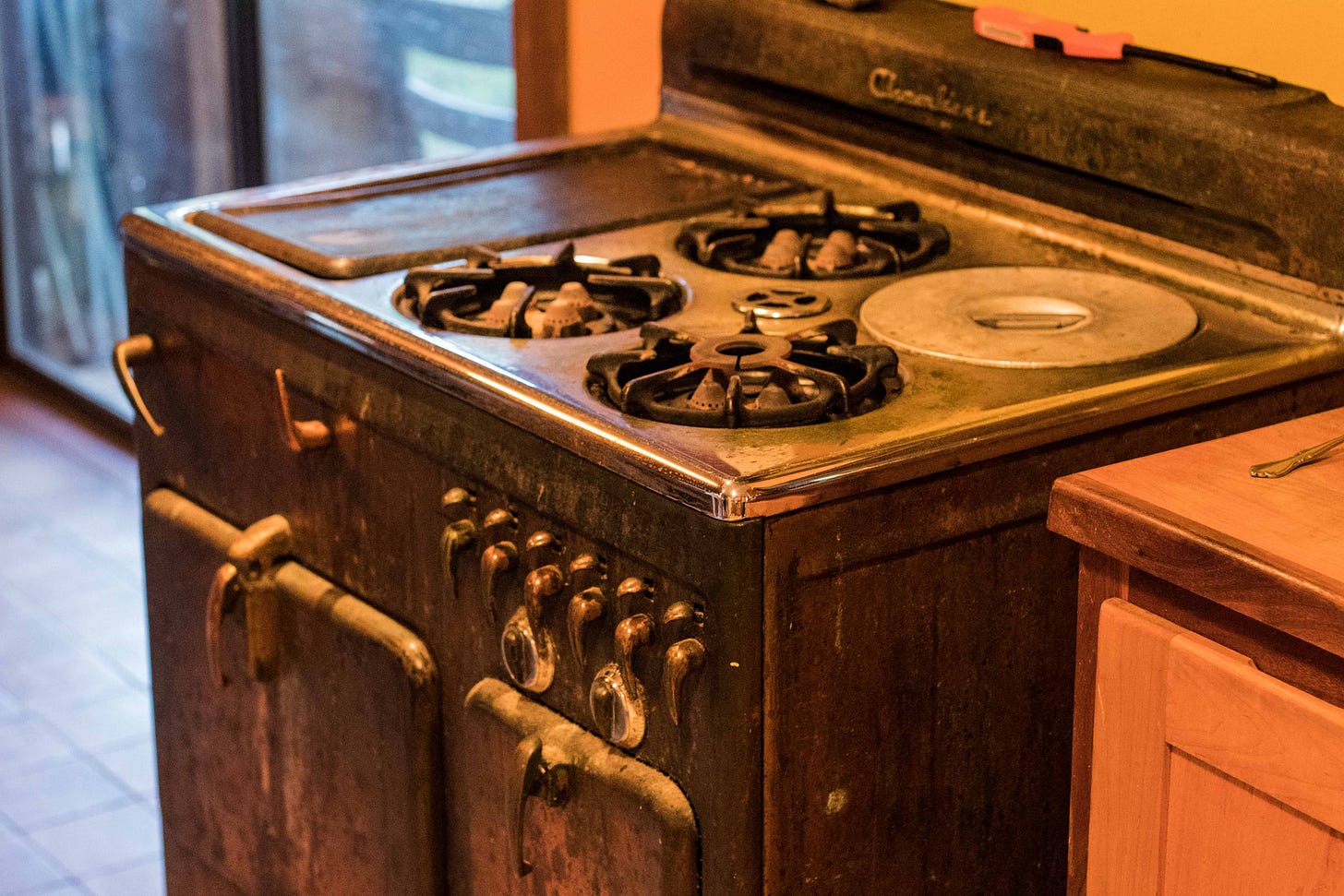
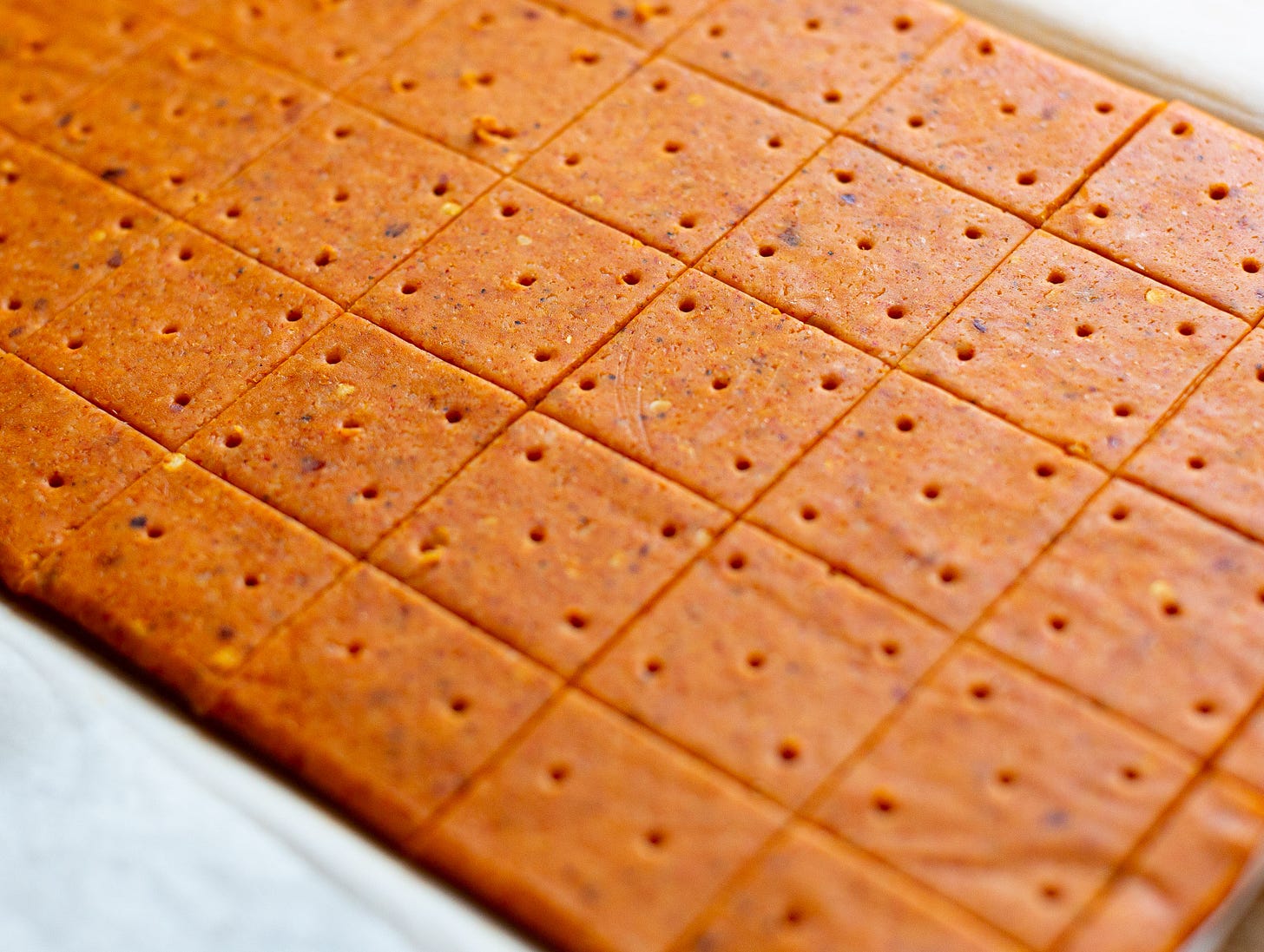
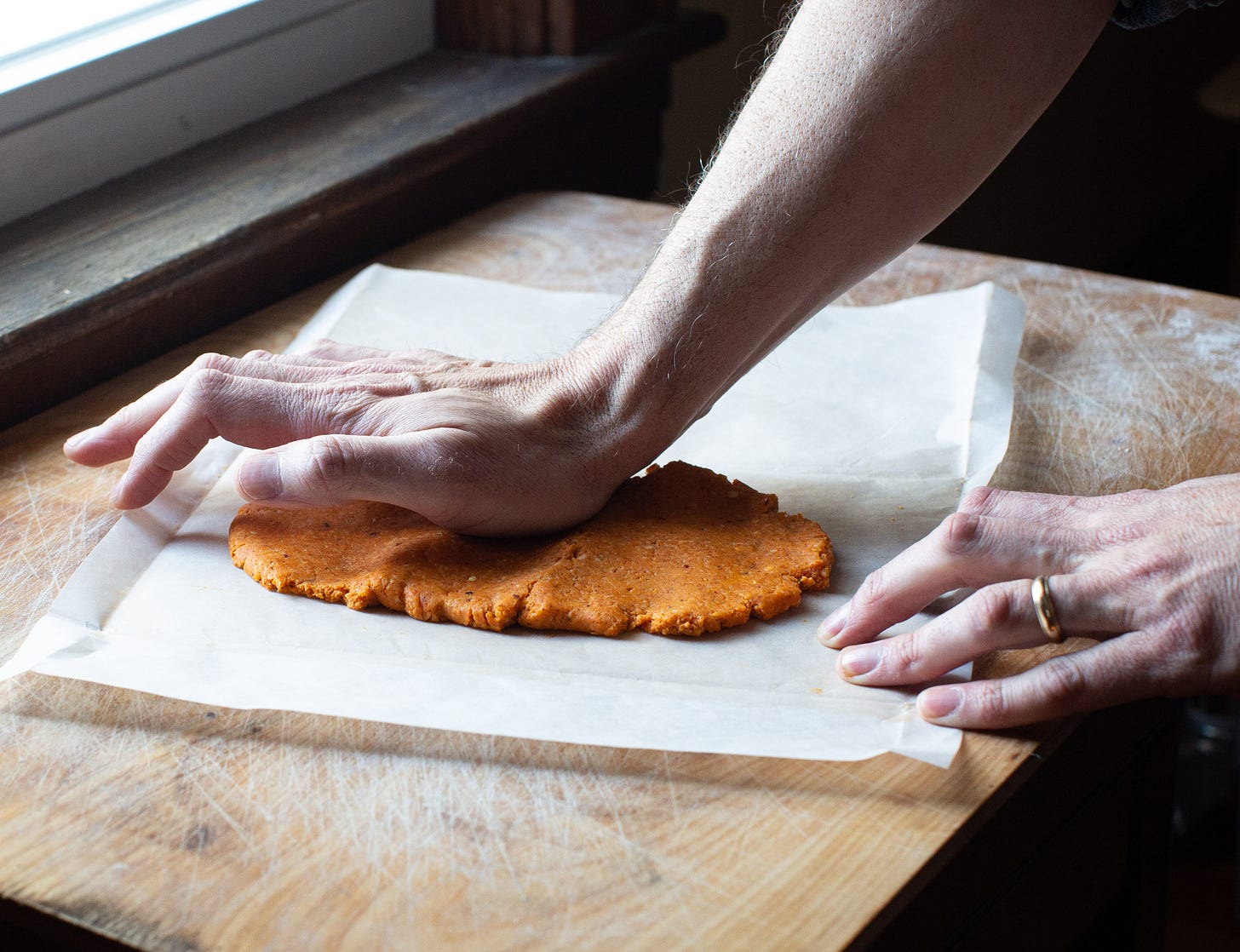
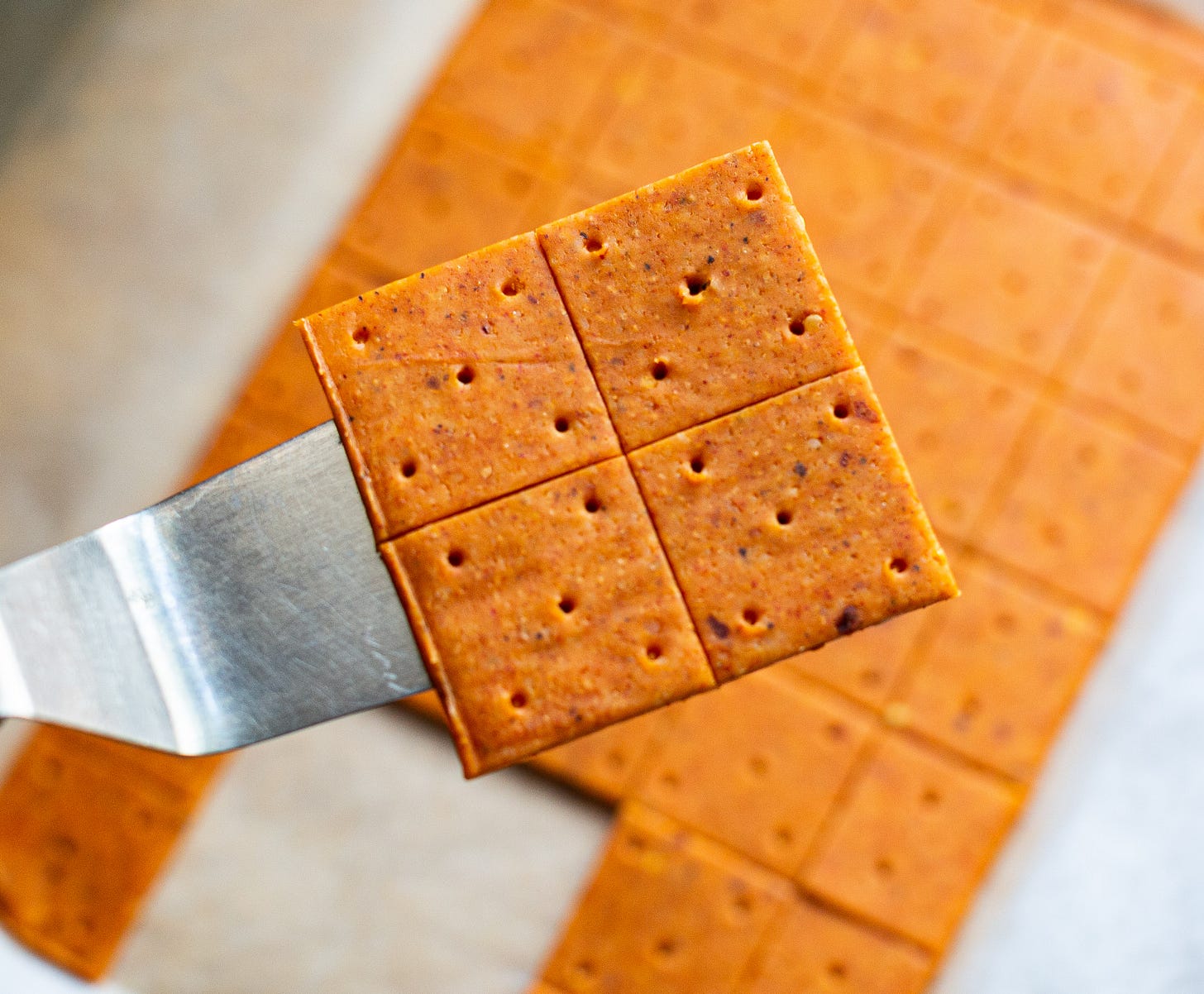
This was a joy, Martin. Well done.
Yum! Love reading about back hill adventures!